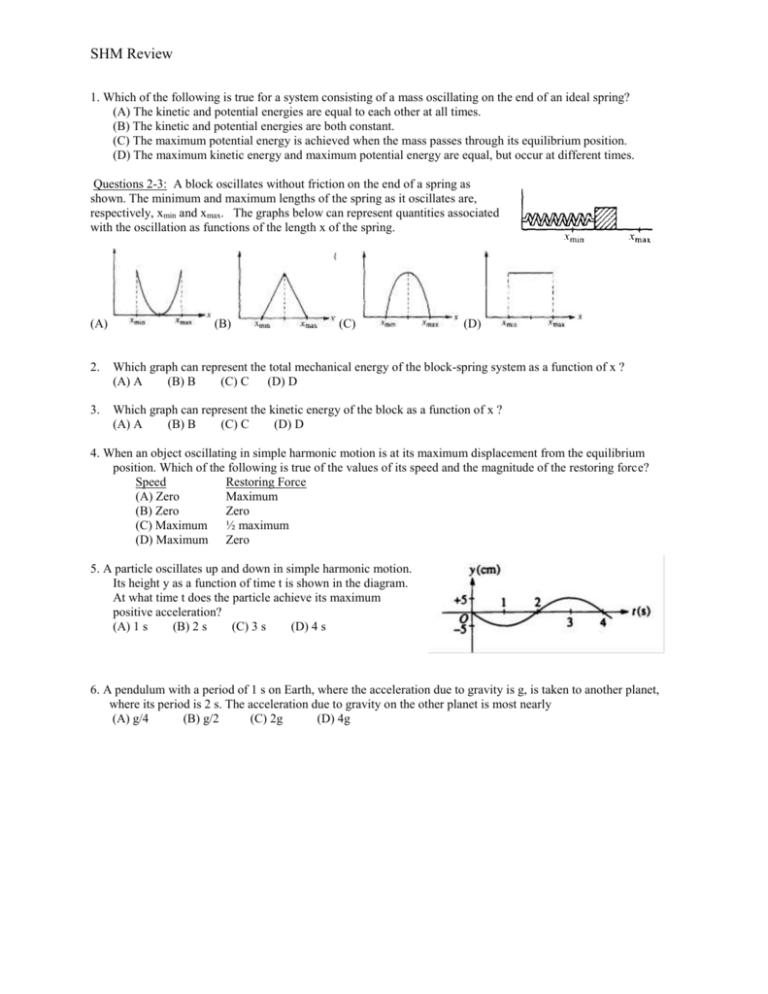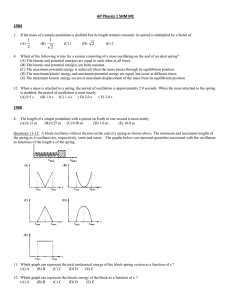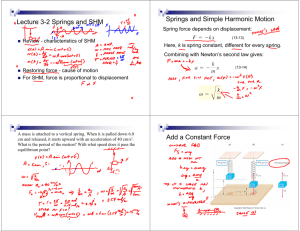SHM Review: Simple Harmonic Motion Practice Questions
advertisement

SHM Review 1. Which of the following is true for a system consisting of a mass oscillating on the end of an ideal spring? (A) The kinetic and potential energies are equal to each other at all times. (B) The kinetic and potential energies are both constant. (C) The maximum potential energy is achieved when the mass passes through its equilibrium position. (D) The maximum kinetic energy and maximum potential energy are equal, but occur at different times. Questions 2-3: A block oscillates without friction on the end of a spring as shown. The minimum and maximum lengths of the spring as it oscillates are, respectively, xmin and xmax. The graphs below can represent quantities associated with the oscillation as functions of the length x of the spring. (A) (B) (C) (D) 2. Which graph can represent the total mechanical energy of the block-spring system as a function of x ? (A) A (B) B (C) C (D) D 3. Which graph can represent the kinetic energy of the block as a function of x ? (A) A (B) B (C) C (D) D 4. When an object oscillating in simple harmonic motion is at its maximum displacement from the equilibrium position. Which of the following is true of the values of its speed and the magnitude of the restoring force? Speed Restoring Force (A) Zero Maximum (B) Zero Zero (C) Maximum ½ maximum (D) Maximum Zero 5. A particle oscillates up and down in simple harmonic motion. Its height y as a function of time t is shown in the diagram. At what time t does the particle achieve its maximum positive acceleration? (A) 1 s (B) 2 s (C) 3 s (D) 4 s 6. A pendulum with a period of 1 s on Earth, where the acceleration due to gravity is g, is taken to another planet, where its period is 2 s. The acceleration due to gravity on the other planet is most nearly (A) g/4 (B) g/2 (C) 2g (D) 4g SHM Review 8. 9. SHM Review 10. A student hangs a 10 kg object on a spring, sets it into oscillation, and obtains the data for the energy of the object as a function of time shown in the graph below. a. What is the period of the oscillation? b. Sketch the position of the mass system as a function of time. Explicitly label any intercepts, asymptotes, maxima, or minima with numerical values, as appropriate. c. Sketch the velocity of the mass system as a function of time. Explicitly label any intercepts, asymptotes, maxima, or minima with numerical values, as appropriate. SHM Review 11.











